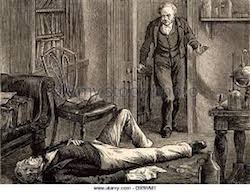Scottish physician James Young Simpson on the floor after using chloroform as an anesthetic on himself in the 1840s.
Jeremy A. Greene, M.D., writing in The New England Journal of Medicine on the headline “Do-It-Yourself Medical Devices — Technology and Empowerment in American Health Care,” concludes:
“Whether doing it yourself is ultimately liberating or dangerous depends on our approach to risk and technological literacy. How do we decide who is competent enough to deal with risks of technological auto-experimentation and who is not? But the same questions could also be asked regarding consumers who purchase expensive wearable technologies and smartphone apps whose claims to produce healthier lives remain unvetted by the FDA. As we try to distinguish hope from hype in the promises made about smart medical devices, it’s important to remember that DIY medical technologies are neither wholly new nor wholly liberating. And in offering means for circumventing physicians, they may well expose patients to new costs and new risks.”




